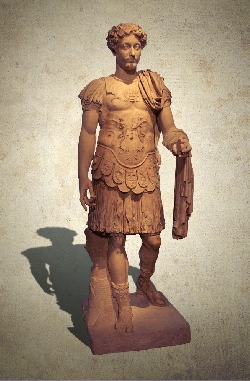A fictional story of a legionnaire
 20-year-old conscript Iulius was recruited in Italy in the fifth year of the rule of Emperor Markus Aurelius (166 AD). He was a single farmer who wanted to earn his living with a service in the legion. He became one of the many recruits of the newly formed Second legion Italica (with a she-wolf in the emblem). In the oath (sacramentum) he promised: "I will always follow an order given to me. I will be fighting in a rank against the enemy. I will never leave the characters. I will not do any harm to the Empire or the Roman people. If this is not the case, let the Jupiter destroy me". This oath was repeated every year on New Year's Day. Then, his four-month intensive training began. New recruits were trained in long marches, practising various combat formations (e.g. turtle), camp building or in mastering practice wooden weapons. Legionnaires were also trained in swimming, horse riding, archery or using handheld slingshots. The first combat deployment took place in the territory of northern Italy where there were defensive fights against German attackers before Aquileia. The legion was then ordered to move away from Italy to the north to the Norikum province where it built a camp in today's Albing near the Danube boundary (Austria) in 170. It is where he participated in many battles with the German tribes of Marcomanni and Quadi. The winter in 179 – 180 he even spent in one of the temporary camps in the depths of Great Germania.
20-year-old conscript Iulius was recruited in Italy in the fifth year of the rule of Emperor Markus Aurelius (166 AD). He was a single farmer who wanted to earn his living with a service in the legion. He became one of the many recruits of the newly formed Second legion Italica (with a she-wolf in the emblem). In the oath (sacramentum) he promised: "I will always follow an order given to me. I will be fighting in a rank against the enemy. I will never leave the characters. I will not do any harm to the Empire or the Roman people. If this is not the case, let the Jupiter destroy me". This oath was repeated every year on New Year's Day. Then, his four-month intensive training began. New recruits were trained in long marches, practising various combat formations (e.g. turtle), camp building or in mastering practice wooden weapons. Legionnaires were also trained in swimming, horse riding, archery or using handheld slingshots. The first combat deployment took place in the territory of northern Italy where there were defensive fights against German attackers before Aquileia. The legion was then ordered to move away from Italy to the north to the Norikum province where it built a camp in today's Albing near the Danube boundary (Austria) in 170. It is where he participated in many battles with the German tribes of Marcomanni and Quadi. The winter in 179 – 180 he even spent in one of the temporary camps in the depths of Great Germania.
His peaceful life was enriched every month by three all-day marches involving camp building. The annual pay of 300 deniers was paid out in four instalments. For this amount, the legionnaire could buy many things and financially secure his loved ones (exchange rate: 1 denier = 4 sestertii = 16 asses).
Price examples
Labourer's pay – 3 - 60 sestertii a working day
Cost of living of an ordinary farmer in Egypt a year – 100 – 150 sestertii
Cost of living of the middle class – up to 450 sestertii
1 modius (8.7 l) of wheat – 4 sestertii
1 modius of barley – 2 sestertii
1 pound (0.3 kg) of bread – 3 asses
1 sextarius of wine (0.5 l) – depending on the quality – 0.3 – 3 sestertii
1 pound of dates, not figs – 1 sestertius
1 pound of pork – 2 sestertii
1 crow – app. 800 sestertii
Trooper – 2,000 – 3,000 sestertii
Ram – up to 200 sestertii
Cheapest slave – 400 – 800 sestertii
Slave with basic education – 200 sestertii
Beautiful slave girl – 4,000 sestertii
Educated and qualified slaves – from 8,000 up to several hundreds of sestertii
Costs of a slave per 1 year – 300 – 600 sestertii
Silver bracelet – from 16 sestertii
Gold bracelet – from 60 sestertii
Ceramic cup (terra sigillata) – from 0.5 asses
Simple village house in Egypt – from 300 sestertii
Two-floor town house in Egypt – from 2,000 sestertii
Small village house in Italy – from 2,000 sestertii
Apartment house in Rome – from 100,000 sestertii
Manor house in Rome (domus) – from 1,500,000 sestertii
Country estate (villa) – around 4,000,000 sestertii
Old pictures and statutes (original pieces) – around 100,000 sestertii
Copies of old statutes – 10,000 – 15,000 sestertii
New statutes – 5,000 – 7,000 sestertii
Book – 4 – 20 sestertii
1 pound of black pepper - 20 sestertii
Simple tunic – 60 sestertii
Tunic of higher quality – up to 300 sestertii
Pair of sandals – 80 sestertii
Service of a barber – at least 2 asses
Admission to the spa – 0.25 – 1 ass
Legionnaire Iulius was discharged from the army in 192 with a salary of 3,000 deniers and a claim for a piece of land in Norik where he bought a house and married his long-term partner with whom he already had several children….(prohibition of marrying related to legionnaires was lifted as late as 197).


